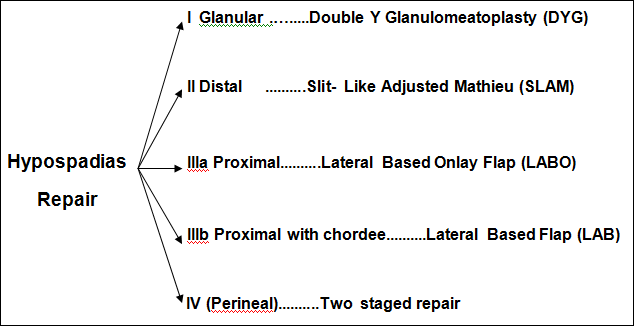FOR DOCTORS – PART III

Fig. 6 a – d: Use of ventral skin distal to the meatus to reconstruct a partially epithelialised neourethra: (a) Duplay incomplete urethroplasty (1880); (b) Denis Browne technique (1949); (c) hinging of the urethral plate (Rich et al. 1989); (d) Snodgrass TIP urethroplasty (1994)
[A] Combined use of prepuce and the skin distal to the meatus
a. Lateral based flap (LAB) by Hadidi (2003, modified 2009).
b. Lateral oblique flap from the side of the penis suggested by Hook (1896).
c. One stage repair for proximal hypospadias by Broadbent (1961).
d. Parameatal foreskin flap described by Koyanagi (1983).
e. Yoke repair described by Snow (1994).
[B] Scrotal skin (not recommended for fear of hairy urethra)
a. Bouisson (1861) was the first to use scrotal skin for urethral reconstruction.
b. Rosenberger (1891) used scrotal tissue for urethroplasty and buried the penis in scrotum.
c. Rochet (1899) used a large scrotal flap for total urethroplasty.
d. Lowsley and Begg (1938) constructed a long urethral tube from scrotum.
e. Beck (1897) suggested Duplay type of urethroplasty and used a rotation flap from scrotum for coverage.
f. Cecil (1946) used a modification of Rosenberger operation following reconstruction of the urethra from ventral penile skin.
[C] Dorsal penile skin
Davis in 1940 tubed the dorsal penile skin with the base proximal in the direction of the circulation. The detached distal end of this tube was passed through a channel in the glans and penis by angulating the penis acutely upward and backward. In the second stage, the proximal pedicle was cut and the penis returned to its normal position. The penile gymnastics required for the Davis procedure apparently seemed too demanding for most surgeons.
[D] Different grafts
a. Nove-Josserand (1897) used a split thickness skin graft on a metal probe.
b. Devine and Horton (1961) used preputial full thickness skin graft in single stage repair.
c. Bracka (1995) used full thickness skin graft in two stage repair.
d. Mommelaar (1947) used bladder mucosa for urethral reconstruction.
e. Humby (1941) first described the use of buccal mucosa for urethral reconstruction.
General principles
The ideal time for surgery is between 3 and 18 months. The infants are amnesic of the procedure and 70 – 80 % of anomalies can be managed on an outpatient basis.
Fine plastic, micro vascular or ophthalmic instruments including sharp serrated scissors are necessary. Optic magnification is helpful, although low magnification will suffice (X 1-2); some use an operating microscope routinely. Sutures like 6/0 or 7/0 Vicryl (polyglactin 910), Monocryl (poliglecaprone 25) or PDS (polydiaxanone) are used for urethroplasty.
To obtain a bloodless field, a tourniquet (released every 30 – 45 min) or Epinephrine (1:100 000) in 1 % lidocaine is used. Haemostasis should be ensured using bipolar diathermy. Urethroplasty should be performed around a 10 Fr catheter to avoid subsequent stenosis. A compressing dressing is applied post-operatively for 6 hours for hemostasis. The author prefers to remove the dressing after 6 hours but many surgeons prefer to use silastic foam or Tegaderm dressing for 2 – 5 days. The author does not leave a catheter inside the urethra routinely because it causes irritation and interferes with healing. However many surgeons leave a 6 Fr silastic catheter for 7 – 10 days.
Choice of operative technique
More than three hundred operations have been described for the treatment of hypospadias. Surgeons have proceeded through Browne repairs and scrotal flaps, to Duplay tubes, to free skin grafts, to island flaps and onlays, to bladder and buccal mucosal repairs, to a host of single-stage innovations, to different concepts of chordee correction and with all manner of bladder drainage systems. However, hypospadias repairs can be grouped into five or six major principles, depending on the tissues used.
For glanular hypospadias with mobile meatus, the author prefers to use the Inverted Y technique. For distal hypospadias, he prefers to use the Y-V glanuloplasty modified Mathieu approach. The author has adopted the lateral-based flap for proximal hypospadias. Two-stage repair may be preferred in patients with perineal hypospadias to avoid the use of hair-bearing areas of skin. Fig. 7 summarises the author’s recommendations for primary hypospadias repair.
Fig. 7: Recommendations for primary hypospadias repair
Grade I or Glanular Hypospadias: “The Double Y Glanuloplasty (DYG)”
This technique is suitable for a limited number of hypospadias patients. It is ideal for patients with glanular hypospadias characterised with mobile meatus. If the meatus is not mobile or can not be brought to the tip of the penis, the technique is contra-indicated.
Operative steps:
- An inverted Y incision is outlined on the glans.
- The two diverging limbs are incised along the upper edge of the meatus.
- The longitudinal limb extends in the midline to the tip of the glans.
- A space is created for the new urethra.
- The inverted Y is sutured as an inverted V preserving the dog ears.
- The glans is freely mobilised to wrap around the urethra.
- Urinary diversion and dressing is applied for 24 hours only.

Fig. 8: The DoubleY Glanuloplasty (DYG) Technique



